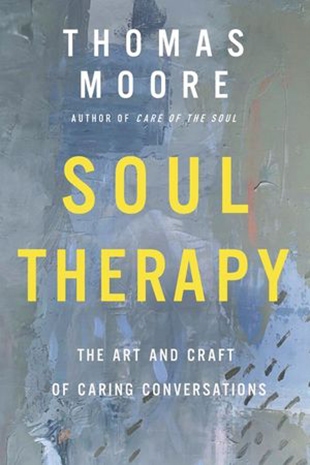S&P's Executive Director Jonathan Ellergy had a "Deeper Conversation" with Thomas Moore about "Soul Therapy" on October 7th. Watch the video below.
Thomas Moore is the author of the New York Times bestseller Care of the Soul. He has written many other books about bringing soul to personal life and culture, deepening spirituality, and doing religion in a fresh way. He is also a psychotherapist influenced mainly by C. G. Jung and James Hillman. He is profiled in S&P's Living Spiritual Teachers Project.
In the introduction to Soul Therapy, Thomas Moore notes that this book explores the versatility and vibrant complexity which enables therapy to "go on anywhere and take many different forms." Therapy blooms as care of the soul when psychologists, social workers, counselors, spiritual directors, family members, and friends reach out and connect with others through "caring, helpful, generous listening and responding."
Moore has a lot of experience with this type of caring. For 12 years, he practiced spirituality as a Catholic monk. He went on to become a teacher of psychiatrists, counselors, social workers, and health care workers. This book is filled with the ideas and practices he has shared with other therapists over the years. But he doesn't think you need to be a professional therapist to benefit from understanding the key concepts and practices of soul care.
"When you get to be older, and the concerns of the day have all been attended to, and you turn to your inner life — well, if you don't know where it is or what it is, you'll be sorry."
-- Joseph Campbell
As a soul-focused therapist, Moore holds great respect for the manifold mysteries of the inner life that are manifested in love, illness, marriage, death, and ideas of the afterlife. As we tell the stories of our lives, we mine the many meanings of both listening and speaking, which he calls "the yin and yang of conversational therapy, two sides of a coin, both intense and generous."
In chapters on the symptom as a vehicle of change, transference as an educational opportunity, building the vessel, getting stuck, the mist of childhood, dream work, and complexes, Moore shares examples from his own therapy practice and shows how a therapist or a friend might learn from them. It's not the same as being in therapy with Moore, but he clearly models different approaches, offering himself as a mentor.
Some of the closing chapters we liked best are "Therapy at Work." "Healing Society's Soul," "Couples in Therapy," "Psychotherapy and Spiritual Direction," and "The Therapist in Everyone." Perhaps our favorite assertion, which appears throughout the book, is that everyone can be a therapist. Listen to these examples:
"We can all find ways to be the world's therapist. My wife is an artist reaching out to the whole world, conscious of the beauty in cultural diversity. My daughter sings in a visionary way with the conscious intention of helping young people avoid the usual addictions. My stepson practices architecture in a way that will help communities thrive. My father was a plumber who taught his students how to set up elegant pipe systems, skillfully welded, to keep water flowing in buildings and homes. He also taught them values of character and responsibility so they could do their job well. These are just a few of my family members, and each one is or was a therapist to the world. Imagine how many people out there are doing informal therapy.
"People make jokes about bartenders and hairdressers listening to their woes, but this is truly a form of therapy, if quite informal and far outside a professional format. Once you get this idea of informal therapy in the world, it's difficult to imagine a job that does not have some therapeutic potential. Therefore, I don't merely advocate therapy for the world but also therapy in the world."
